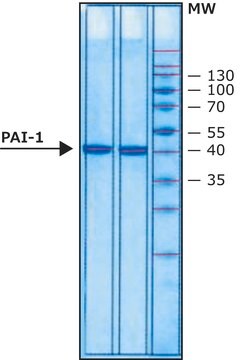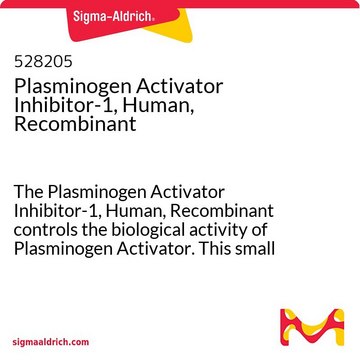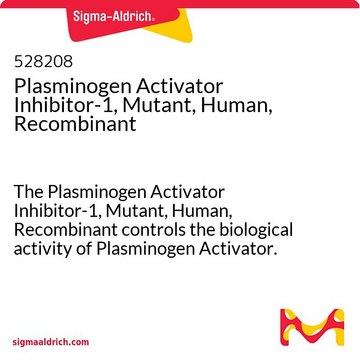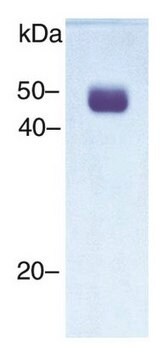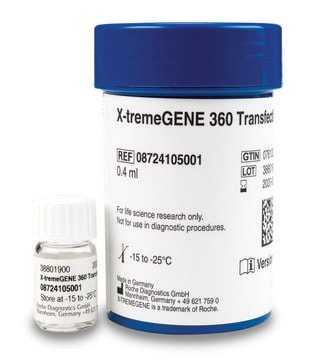CC4075
Human Plasminogen activator inhibitor-1
liquid, ≥98% (SDS-PAGE), suitable for activity assay
Sinonimo/i:
PAI 1, SERPINE1, PAI1
Autenticatiper visualizzare i prezzi riservati alla tua organizzazione & contrattuali
About This Item
Codice UNSPSC:
12352202
eCl@ss:
32160405
NACRES:
NA.77
Prodotti consigliati
product name
Human Plasminogen activator inhibitor-1, recombinant,
Origine biologica
human
Livello qualitativo
Saggio
≥98% (SDS-PAGE)
Forma fisica
liquid
Produttore/marchio commerciale
Chemicon®
tecniche
activity assay: suitable
Impurezze
<1 EU/μg endotoxin
N° accesso NCBI
N° accesso UniProt
Condizioni di spedizione
dry ice
Descrizione generale
Plasminogen activator inhibitor-1 (PAI-1) is a member of the serine protease inhibitor (serpin) superfamily and a central regulatory protein in the blood coagulation system. PAI-1 is unique among serpins in exhibiting distinct active and inactive (latent) conformations in vivo. Human PAI-1 is a single-chain glycoprotein with a molecular weight of 43 kDa. This inhibitor acts as "bait" for tissue-type and urokinase-type plasminogen activators (tPA and uPA) and protein C. Its rapid interaction with tPA may function as a major control point in the regulation of fibrinolysis. The highly mobile reactive-center loop (RCL) is thought to account for both the rapid inhibiton of plasminogen activators, and the rapid and spontaneous transition of the unstable, active form of PAI-1 into the stable, inactive conformation (t1/2 at 37oC, 2 hours). The inactive form can be partially reactivated by denaturants such as urea, guanidine hydrochloride or SDS. High concentrations of PAI-1 have been associated with human thromboembolic disease. PAI-1 activity may limit the extent of tumor metastasis, since uPA activity is a major contributory factor promoting dissolution of tumor matrix and basement membrane.
The sequence corresponding to amino acids 24 to 402 of human PAI-1 (mature form) tagged with 6xHis on the carboxy-terminal was expressed in E. Coli.
Applicazioni
To fully activate the latent PAI-1, the PAI-1 must be incubated in Activation Buffer (2X Activation Buffer: 8 M Guanidine HCl, 40 mM Sodium Acetate, pH 5.6, 400 mM NaCl, 0.2% Tween 20) for 15 to 30 minutes (Sancho, 1994).The recombinant PAI-1 is able to bind to uPA resulting in a SDS-stable complex.
Stato fisico
Liquid. In 150 mM Na2HPO4, pH 6.6, 500 mM NaCl, 2 mM Glutathione, and 0.01% Tween-80.
Stoccaggio e stabilità
Store at -80ºC. Thaw on ice and freeze aliquots at -80ºC for longer storage. This product is stable for at least 2 years as supplied. Avoid repeated freeze/thaw cycles.
Risultati analitici
Specific Activity: By uPA activity assay, the recombinant PAI-1 contains a mixture of the active and latent forms, with >45% of active form
Note legali
CHEMICON is a registered trademark of Merck KGaA, Darmstadt, Germany
Esclusione di responsabilità
Unless otherwise stated in our catalog or other company documentation accompanying the product(s), our products are intended for research use only and are not to be used for any other purpose, which includes but is not limited to, unauthorized commercial uses, in vitro diagnostic uses, ex vivo or in vivo therapeutic uses or any type of consumption or application to humans or animals.
Codice della classe di stoccaggio
10 - Combustible liquids
Classe di pericolosità dell'acqua (WGK)
WGK 2
Punto d’infiammabilità (°F)
Not applicable
Punto d’infiammabilità (°C)
Not applicable
Certificati d'analisi (COA)
Cerca il Certificati d'analisi (COA) digitando il numero di lotto/batch corrispondente. I numeri di lotto o di batch sono stampati sull'etichetta dei prodotti dopo la parola ‘Lotto’ o ‘Batch’.
Possiedi già questo prodotto?
I documenti relativi ai prodotti acquistati recentemente sono disponibili nell’Archivio dei documenti.
P M Sherman et al.
The Journal of biological chemistry, 267(11), 7588-7595 (1992-04-15)
Plasminogen activator inhibitor-1 (PAI-1) is a specific inhibitor of the serine proteases tissue-type plasminogen activator (tPA) and urokinase-type plasminogen activator (uPA). To systematically investigate the roles of the reactive center P1 and P1' residues in PAI-1 function, saturation mutagenesis was
Il team dei nostri ricercatori vanta grande esperienza in tutte le aree della ricerca quali Life Science, scienza dei materiali, sintesi chimica, cromatografia, discipline analitiche, ecc..
Contatta l'Assistenza Tecnica.